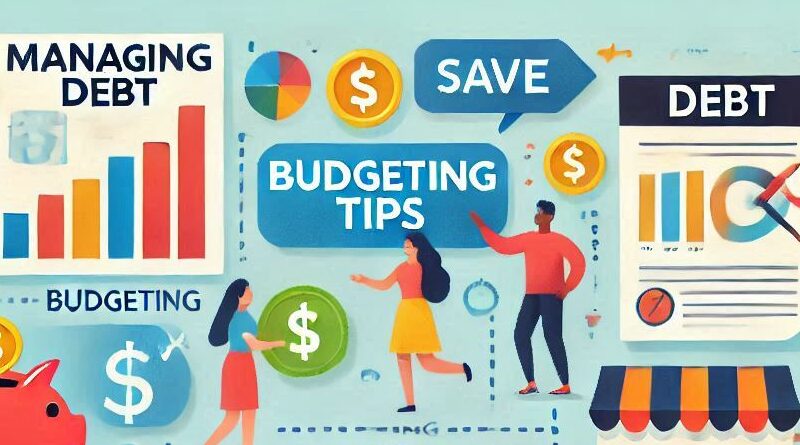
Debt Management: How to Avoid Getting Stuck in Debt
In the bustling city of Rivertown, lived a young professional named Emma. She was determined to manage her finances wisely and avoid getting stuck in debt. Inspired by her goal of financial freedom in “Debt Management: How to Avoid Getting Stuck in Debt”, Emma embarked on a journey to discover effective debt management strategies.
Contents
- 1 Understanding Debt Management
- 2 Creating a Budget
- 3 Prioritizing Debt Repayment
- 4 Avoiding New Debt
- 5 Building an Emergency Fund
- 6 Using Debt Consolidation
- 7 Seeking Professional Help
- 8 Practicing Mindful Spending
- 9 Automating Payments
- 10 Building Good Credit Habits
- 11 Living Below Your Means
- 12 Using Cash for Discretionary Spending
- 13 Educating Yourself About Personal Finance
- 14 Negotiating Bills and Expenses
- 15 Avoiding Impulse Purchases
- 16 Seeking Support from a Financial Community
- 17 Planning for Major Expenses
- 18 Practicing Gratitude and Contentment
- 19 Reviewing Financial Goals Regularly
- 20 Celebrating Milestones
Understanding Debt Management
Emma began by understanding the importance of Debt Management: How to Avoid Getting Stuck in Debt. It wasn’t just about paying off debt but also about making smart financial decisions to prevent future debt. She knew that managing debt effectively would lead to financial stability and peace of mind.
Creating a Budget
The first step Emma took was creating a budget. By tracking her income and expenses, she identified areas where she could cut back. She used budgeting apps like Mint and YNAB (You Need A Budget) to monitor her spending and ensure she stayed on track. This foundation was crucial for her debt management journey.
Prioritizing Debt Repayment
Emma prioritized her debt repayment by focusing on high-interest debts first. She made extra payments towards her credit card debt while continuing to make minimum payments on other loans. This strategy helped her reduce the overall interest she paid and accelerated her debt repayment.
Avoiding New Debt
To avoid getting stuck in debt, Emma made a conscious effort to avoid taking on new debt. She resisted the temptation to use credit cards for unnecessary purchases and focused on living within her means. This discipline was key to her financial success.
Building an Emergency Fund
One of Emma’s primary goals was to build an emergency fund. By saving a portion of her income each month, she created a financial safety net. This fund provided peace of mind and protected her from unexpected expenses that could lead to debt.
Using Debt Consolidation
Emma explored debt consolidation as a strategy to manage her debt. By consolidating multiple debts into a single loan with a lower interest rate, she simplified her payments and reduced her overall interest costs. This approach made her debt more manageable.
Seeking Professional Help
When feeling overwhelmed, Emma didn’t hesitate to seek professional help. She consulted with a financial advisor who provided valuable guidance and support. This professional advice helped her create a personalized debt management plan.

Practicing Mindful Spending
Emma adopted mindful spending habits to avoid unnecessary expenses. She made a list of needs versus wants and focused on spending money on essentials. This practice helped her stay within her budget and avoid impulse purchases.
Automating Payments
To ensure she never missed a payment, Emma set up automatic payments for her bills and loans. This automation helped her avoid late fees and maintain a good credit score. It also made managing her finances more convenient.
Building Good Credit Habits
Emma understood the importance of building good credit habits. She paid her bills on time, kept her credit card balances low, and avoided opening too many new accounts. These habits helped her maintain a good credit score and access better loan terms.
Living Below Your Means
Emma adopted the principle of living below her means. She focused on spending less than she earned and avoided lifestyle inflation. This practice allowed her to save more money and reduce her reliance on credit.
Using Cash for Discretionary Spending
To control her spending, Emma started using cash for discretionary expenses like dining out and entertainment. By setting a cash budget for these activities, she could avoid overspending and stay within her financial limits.
Educating Yourself About Personal Finance
Emma invested time in educating herself about personal finance. She read books, attended workshops, and followed financial blogs. This knowledge empowered her to make informed decisions and avoid common financial pitfalls.
Negotiating Bills and Expenses
Emma learned the art of negotiating bills and expenses. She contacted service providers to negotiate lower rates for utilities, insurance, and other recurring expenses. This proactive approach helped her save money and reduce her monthly bills.

Avoiding Impulse Purchases
To avoid impulse purchases, Emma made a habit of creating a shopping list before going to the store. She also implemented a 24-hour rule for non-essential purchases, giving herself time to consider whether she truly needed the item.
Seeking Support from a Financial Community
Emma joined a financial community where she could share her experiences and learn from others. This support network provided valuable insights, encouragement, and accountability, helping her stay on track with her debt management goals.
Planning for Major Expenses
Emma planned for major expenses like vacations, home repairs, and holidays. By setting aside money in advance, she could avoid relying on credit cards and loans to cover these costs. This foresight helped her stay debt-free.
Practicing Gratitude and Contentment
Emma practiced gratitude and contentment to avoid the trap of materialism. She focused on appreciating what she had rather than constantly seeking more. This mindset shift helped her resist the urge to spend money on unnecessary items.
Reviewing Financial Goals Regularly
Emma made it a habit to review her financial goals regularly. By tracking her progress and making adjustments as needed, she stayed motivated and committed to her debt management plan. This ongoing review ensured she stayed on the path to financial freedom.
Celebrating Milestones
To stay motivated, Emma celebrated her financial milestones. Whether it was paying off a loan or reaching a savings goal, she acknowledged her achievements. These celebrations kept her excited and committed to her debt management plan.
As Emma implemented these Debt Management: How to Avoid Getting Stuck in Debt strategies, she noticed a significant improvement in her finances. Her journey showed that with discipline, mindfulness, and the right strategies, anyone could avoid getting stuck in debt and achieve financial stability.







Pingback: Planning for Early Retirement: What you Need to Know - storiesbay
Pingback: Investing: How to Start Investing With Little Money - storiesbay
This actually answered my problem, thanks!
After I initially commented I clicked the -Notify me when new comments are added- checkbox and now each time a comment is added I get 4 emails with the identical comment. Is there any method you’ll be able to take away me from that service? Thanks!
Noted
I am really loving the theme/design of your website. Do you ever run into any browser compatibility problems? A couple of my blog readers have complained about my website not operating correctly in Explorer but looks great in Chrome. Do you have any suggestions to help fix this problem?
After a thorough research here are some ways to address the issue of your website not working correctly in Internet Explorer (IE) while functioning well in Chrome, you’ll need to tackle browser compatibility issues. Here are practical steps to diagnose and fix the problem:
1. Identify the Issue:
– Ask your readers for specifics: What version of IE are they using (e.g., IE11, Edge)? What exactly isn’t working (layout issues, broken features, JavaScript errors)?
– Test your website in IE yourself. Use tools like BrowserStack or a virtual machine to simulate different IE versions if you don’t have access to the browser.
2. Check for Common Compatibility Issues:
– CSS Compatibility: IE, especially older versions, has limited support for modern CSS properties (e.g., Flexbox, Grid, or CSS variables). Use tools like CanIUse.com to check if the CSS features you’re using are supported in IE.
– Fix: Add fallbacks or alternative styles for IE. For example, if using Flexbox, include a float-based or display: block fallback.
– Example:
“`css
.container {
display: flex;
/* Fallback for IE */
display: block;
}
@media screen and (-ms-high-contrast: active), (-ms-high-contrast: none) {
/* IE-specific styles */
.container {
display: block;
}
}
“`
– JavaScript Compatibility: IE may not support modern JavaScript features like arrow functions, `let/const`, or `async/await`.
– Fix: Use a transpiler like Babel to convert modern JavaScript to ES5, which is widely supported in IE. Ensure you include polyfills (e.g., via `core-js` or `polyfill.io`) for features like `Promise` or `Array.includes`.
– Example for polyfill inclusion:
“`html
“`
– Vendor Prefixes: Some CSS properties in IE require vendor prefixes (`-ms-`).
– Fix: Use a tool like Autoprefixer in your CSS build process to automatically add necessary prefixes.
3. Validate Your Code:
– Run your HTML and CSS through validators (e.g., W3C HTML Validator, CSS Validator) to catch syntax errors that might break in IE.
– Ensure your HTML includes a valid `` declaration to avoid quirks mode in IE.
4. Debug JavaScript Errors:
– Open IE’s Developer Tools (F12) and check the Console for errors. IE often chokes on unsupported methods or syntax.
– Fix: If you see errors like “Object doesn’t support property or method,” add polyfills or rewrite the code to use IE-compatible methods.
5. Test for Responsive Design Issues:
– IE may struggle with media queries or viewport settings. Ensure your `` tag is set correctly:
“`html
“`
– If layouts break, test your media queries in IE and consider simplifying them or using feature detection with Modernizr.
6. Use Feature Detection:
– Instead of browser sniffing (detecting IE specifically), use feature detection to apply fixes only when needed.
– Example with Modernizr:
“`html
“`
7. Consider Progressive Enhancement:
– Build a functional baseline for IE (simpler styles, basic functionality) and enhance the experience for modern browsers like Chrome.
– Example: Use basic CSS for IE, then add advanced features like animations for Chrome via `@supports`:
“`css
@supports (display: grid) {
.container {
display: grid;
}
}
“`
8. Test and Iterate:
– After making changes, test in multiple IE versions and Chrome to ensure no regressions.
– Use tools like BrowserStack, Sauce Labs, or local IE installations for testing.
9. Communicate with Readers:
– If the fixes don’t fully resolve issues in older IE versions (e.g., IE9 or below), consider informing readers to upgrade to a modern browser like Edge or Chrome for the best experience, as supporting very old browsers may not be feasible.
10. Leverage a Framework or Reset:
– Use a CSS reset (e.g., Normalize.css) to ensure consistent rendering across browsers.
– If your site uses a front-end framework (e.g., Bootstrap), ensure you’re using a version with IE support, and check their documentation for IE-specific fixes.
I hope the above will help you out!